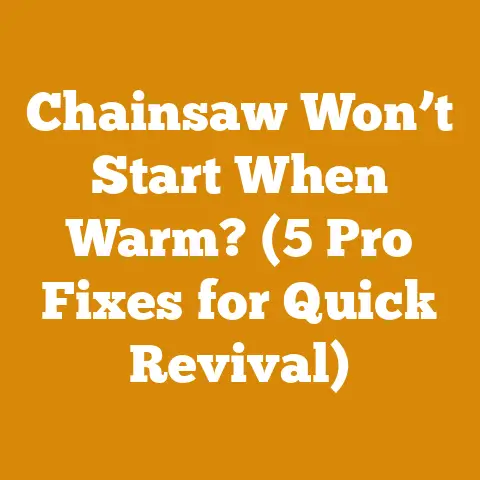Wood Boiler DIY Guide (5 Expert Tips for Efficient Outdoor Heating)
Layering up for winter is about more than just clothes; it’s about preparing your home for the chill. And for many, that means considering a wood boiler. Now, before you conjure images of massive industrial furnaces, let’s clarify: I’m talking about a DIY-friendly outdoor wood boiler, a system that can efficiently heat your home and even your domestic hot water. Trust me, I’ve been there, done that, and got the (slightly sooty) t-shirt.
I remember back in ’08, when oil prices skyrocketed, the thought of relying solely on fossil fuels sent shivers down my spine – and not the good kind. That’s when I started seriously considering a wood boiler. The initial investment seemed daunting, but the promise of energy independence and lower heating bills was too tempting to ignore. I dove headfirst into research, devoured every article and forum post I could find, and eventually, built my own system. It wasn’t without its bumps and bruises, both literally and financially, but the lessons I learned were invaluable. And that’s exactly what I want to share with you in this guide: the practical, cost-conscious approach to building your own efficient outdoor wood boiler.
Wood Boiler DIY Guide (5 Expert Tips for Efficient Outdoor Heating)
Building your own outdoor wood boiler is a project that blends self-reliance with sustainable living. It’s a rewarding endeavor, but it’s crucial to approach it with a clear understanding of the costs involved and the factors that influence them. This guide provides five expert tips to help you create an efficient and cost-effective outdoor heating system.
Tip 1: Designing for Efficiency and Cost-Effectiveness
Before you even think about picking up a wrench or ordering materials, the design phase is paramount. A well-thought-out design can significantly impact the efficiency of your wood boiler and, consequently, its long-term cost-effectiveness.
Understanding Heat Load: The first step is determining your heat load. This is the amount of energy required to maintain a comfortable temperature in your home during the coldest months. Factors influencing heat load include:
- Climate: Obviously, colder climates require a higher heat load.
- House Size and Insulation: Larger, poorly insulated homes will demand more energy.
- Window Efficiency: Single-pane windows are energy vampires, bleeding heat relentlessly.
- Air Leakage: Drafts can significantly increase your heating needs.
I remember underestimating my heat load back in the day. I thought, “Ah, it’s just a small farmhouse, how much heat can it possibly need?” I quickly learned that the century-old farmhouse, with its original windows and less-than-stellar insulation, was a heat-sucking monster. I ended up having to upgrade my boiler size much sooner than anticipated, costing me extra time and money.
Calculating Heat Load: There are several ways to calculate heat load, ranging from simple rules of thumb to more sophisticated methods.
- Rule of Thumb: A common rule of thumb is to estimate 25-50 BTU (British Thermal Units) per square foot of living space. However, this is a very rough estimate and should only be used as a starting point.
- Manual J Calculation: This is a more accurate method that takes into account all the factors mentioned above. You can find online calculators and software to assist with this calculation.
- Energy Audit: A professional energy audit can provide the most accurate assessment of your heat load. While it comes with a cost, it can save you money in the long run by identifying areas where you can improve energy efficiency.
Boiler Sizing: Once you know your heat load, you can select the appropriate boiler size. It’s crucial to avoid oversizing the boiler. An oversized boiler will cycle on and off frequently, reducing efficiency and increasing wear and tear. Aim for a boiler that can comfortably meet your peak heat load without being excessively large.
Design Considerations:
- Combustion Chamber: Design a combustion chamber that promotes complete combustion of the wood. This will reduce emissions and maximize efficiency.
- Heat Exchanger: A well-designed heat exchanger will efficiently transfer heat from the combustion gases to the water.
- Insulation: Insulate the boiler thoroughly to minimize heat loss.
- Water Capacity: A larger water capacity will provide more thermal mass, reducing temperature fluctuations and improving efficiency.
- Draft Control: Implement a draft control system to regulate the airflow to the combustion chamber.
Cost Implications:
- Design Software/Consultation: $0 – $500 (depending on the complexity and whether you hire a professional).
- Oversized Boiler: Increased material costs, reduced efficiency, and higher fuel consumption.
- Poor Insulation: Increased heat loss and higher fuel consumption.
Data and Statistics: According to the EPA, a properly sized and operated wood boiler can reduce heating costs by 30-50% compared to traditional fossil fuel systems. However, an improperly designed or operated boiler can be significantly less efficient and even emit more pollutants.
Tip 2: Sourcing Materials and Managing Costs
The materials you choose will directly impact the boiler’s performance, longevity, and overall cost. Sourcing these materials wisely is crucial for staying within budget.
Steel Selection: Steel is the backbone of your wood boiler. You’ll need to choose the right type and thickness of steel for the combustion chamber, water jacket, and outer shell.
- Combustion Chamber: High-temperature steel is essential for the combustion chamber, as it needs to withstand extreme heat. A common choice is A36 steel, known for its weldability and strength.
- Water Jacket: The water jacket should be made of steel that is resistant to corrosion. A36 or stainless steel are good options.
- Outer Shell: The outer shell can be made of mild steel, as it is not exposed to extreme temperatures.
Steel Thickness: The thickness of the steel will depend on the size and pressure of the boiler. Consult with a welding professional or engineer to determine the appropriate thickness for your specific design.
Insulation Materials: Insulation is critical for minimizing heat loss. Choose a high-quality insulation material that can withstand high temperatures.
- Mineral Wool: Mineral wool is a popular choice due to its excellent insulation properties and fire resistance.
- Ceramic Fiber Blanket: Ceramic fiber blanket is another good option, especially for high-temperature applications.
Piping and Fittings: Select high-quality piping and fittings that are compatible with your heating system.
- PEX: PEX (cross-linked polyethylene) is a flexible and durable piping material that is commonly used for radiant heating systems.
- Copper: Copper is another option, but it is more expensive than PEX.
Pump and Controls: A circulation pump is needed to circulate the hot water through your heating system. Choose a pump that is appropriately sized for your heat load and piping system. You’ll also need controls to regulate the temperature and operation of the boiler.
Sourcing Strategies:
- Local Steel Suppliers: Check with local steel suppliers for the best prices on steel.
- Online Retailers: Online retailers can offer competitive prices on insulation, piping, and fittings.
- Salvage Yards: Consider sourcing some materials from salvage yards, such as steel plates or pipes. However, be sure to inspect the materials carefully for any damage or defects.
I once found a massive steel plate at a salvage yard for a fraction of the price of new steel. It was a bit rusty, but after a good cleaning and some welding, it was perfect for the outer shell of my boiler. It saved me a significant amount of money.
Cost Breakdown (Estimated):
- Steel: $500 – $1500 (depending on the type and thickness)
- Insulation: $200 – $500
- Piping and Fittings: $300 – $700
- Pump and Controls: $200 – $500
- Welding Supplies: $100 – $300
- Total: $1300 – $3500
Cost Optimization Tips:
- Plan Ahead: Order materials well in advance to avoid rush shipping charges.
- Shop Around: Compare prices from different suppliers.
- Buy in Bulk: If possible, buy materials in bulk to get a discount.
- Negotiate: Don’t be afraid to negotiate prices with suppliers.
- Consider Used Materials: Salvage yards can be a great source of affordable materials.
Data and Statistics: The price of steel can fluctuate significantly depending on market conditions. According to the Steel Index, the price of hot-rolled coil steel has ranged from $600 to $1200 per ton in recent years.
Tip 3: Mastering Welding and Fabrication Techniques
Welding is the heart and soul of building a wood boiler. Strong, leak-proof welds are essential for the boiler’s structural integrity and safe operation. If you’re not a seasoned welder, now’s the time to brush up on your skills or consider hiring a professional.
Welding Techniques:
- MIG (Gas Metal Arc Welding): MIG welding is a popular choice for welding steel due to its speed and ease of use.
- Stick (Shielded Metal Arc Welding): Stick welding is a more versatile technique that can be used on a wider range of materials, including rusty or dirty steel.
- TIG (Gas Tungsten Arc Welding): TIG welding is the most precise welding technique, but it is also the most difficult to master. It is often used for welding stainless steel or aluminum.
Welding Safety: Welding is a dangerous activity that requires proper safety precautions. Always wear a welding helmet, gloves, and protective clothing. Work in a well-ventilated area to avoid inhaling fumes.
Fabrication Techniques:
- Cutting: You’ll need to cut the steel to the appropriate sizes and shapes. A plasma cutter or oxy-acetylene torch can be used for this purpose.
- Bending: You may need to bend the steel to create curved surfaces. A metal brake or hydraulic press can be used for this.
- Drilling: You’ll need to drill holes for pipes, fittings, and other components.
DIY vs. Professional Welding:
- DIY: If you have experience welding and fabricating steel, you can save money by doing the work yourself. However, be sure to take your time and pay attention to detail.
- Professional: If you’re not comfortable welding or fabricating steel, it’s best to hire a professional. A professional welder will have the skills and experience to ensure that the boiler is built safely and correctly.
I remember attempting to weld the combustion chamber myself. Let’s just say the results were less than stellar. My welds looked like a toddler had attacked the steel with a hot glue gun. I ended up grinding them down and re-welding them myself, but the experience taught me a valuable lesson: sometimes it’s worth paying a professional to do the job right.
Cost Implications:
- Welding Equipment: $500 – $2000 (depending on the type and quality of equipment)
- Welding Supplies: $100 – $300
- Professional Welding Services: $50 – $100 per hour
Cost Optimization Tips:
- Rent Welding Equipment: If you only need to weld occasionally, consider renting welding equipment instead of buying it.
- Take a Welding Class: A welding class can teach you the skills you need to weld safely and effectively.
- Practice: Practice your welding skills on scrap metal before working on the boiler.
- Get a Second Opinion: If you’re unsure about your welding skills, ask a friend or professional to inspect your welds.
Data and Statistics: According to the American Welding Society, the average hourly wage for a welder in the United States is $20-$30. However, experienced welders can earn significantly more.
Tip 4: Integrating the Boiler into Your Heating System
Connecting your wood boiler to your existing heating system requires careful planning and execution. You’ll need to consider the type of heating system you have, the distance between the boiler and your home, and the necessary safety precautions.
Heating System Compatibility:
- Radiant Heating: Radiant heating systems are a good match for wood boilers, as they operate at relatively low temperatures.
- Forced Air Heating: Forced air heating systems can also be used with wood boilers, but you’ll need to install a heat exchanger to transfer the heat from the boiler water to the air.
- Hydronic Baseboard Heating: Hydronic baseboard heating systems are another option, but they require a higher water temperature than radiant heating systems.
Piping Distance: The distance between the boiler and your home will affect the size of the piping and the amount of heat loss. The longer the distance, the larger the piping you’ll need to minimize heat loss.
Piping Insulation: Insulate the piping thoroughly to minimize heat loss. This is especially important for long piping runs.
Expansion Tank: An expansion tank is needed to accommodate the expansion and contraction of the water as it heats and cools.
Safety Features:
- Pressure Relief Valve: A pressure relief valve is essential for preventing the boiler from over-pressurizing.
- Temperature Relief Valve: A temperature relief valve is needed to prevent the boiler from overheating.
- Low Water Cutoff: A low water cutoff will shut down the boiler if the water level gets too low.
Installation Considerations:
- Permits: Check with your local building department to see if you need any permits to install a wood boiler.
- Clearance: Maintain adequate clearance around the boiler for safety and maintenance.
- Foundation: The boiler should be installed on a solid, level foundation.
- Weather Protection: Protect the boiler from the weather with a shed or enclosure.
I made the mistake of not properly insulating the underground piping between my boiler and my house. The heat loss was significant, especially during the coldest months. I ended up having to dig up the piping and re-insulate it, which was a major pain. Lesson learned: don’t skimp on insulation!
Cost Implications:
- Piping and Fittings: $300 – $700
- Expansion Tank: $50 – $150
- Safety Features: $100 – $300
- Installation Labor: $50 – $100 per hour (if hiring a professional)
- Permits: $50 – $200
- Shed or Enclosure: $500 – $2000
Cost Optimization Tips:
- Minimize Piping Distance: Locate the boiler as close to your home as possible to minimize piping distance.
- Insulate Piping Thoroughly: Use high-quality insulation to minimize heat loss.
- DIY Installation: If you’re comfortable with plumbing and electrical work, you can save money by doing the installation yourself.
- Shop Around for Permits: Some building departments charge more for permits than others.
Data and Statistics: According to the U.S. Department of Energy, heat loss from uninsulated piping can account for up to 20% of your heating costs.
Tip 5: Fueling Your Boiler: Wood Selection and Preparation
The type of wood you burn and how you prepare it will significantly impact the efficiency of your wood boiler. Choosing the right wood and drying it properly is crucial for maximizing heat output and minimizing emissions.
Wood Species:
- Hardwoods: Hardwoods, such as oak, maple, and ash, are denser than softwoods and produce more heat per volume. They also burn longer and cleaner.
- Softwoods: Softwoods, such as pine and fir, are less dense than hardwoods and produce less heat per volume. They also burn faster and dirtier.
Moisture Content:
- Seasoned Wood: Seasoned wood has been dried for at least six months and has a moisture content of 20% or less. Seasoned wood burns more efficiently and produces less smoke.
- Green Wood: Green wood has a high moisture content and burns poorly. It produces less heat and more smoke. Burning green wood can also damage your boiler.
Wood Preparation:
- Splitting: Splitting wood increases its surface area, allowing it to dry faster and burn more efficiently.
- Stacking: Stacking wood properly allows air to circulate, which helps it dry faster.
- Covering: Covering wood with a tarp or shed will protect it from rain and snow, which can slow down the drying process.
Fuelwood Costs:
- Purchase: You can purchase firewood from local suppliers. The price of firewood varies depending on the species, moisture content, and location.
- Harvesting: If you have access to a woodlot, you can harvest your own firewood. This can save you money, but it requires more time and effort.
I once tried to burn green pine in my boiler. It was a disaster. The fire was smoky and sluggish, and the boiler struggled to maintain temperature. I quickly learned that seasoned hardwood is the way to go. Now, I spend my summers splitting and stacking wood, ensuring that I have a good supply of dry fuel for the winter.
Cost Implications:
- Firewood Purchase: $150 – $300 per cord (depending on the species and location)
- Chainsaw: $200 – $500
- Wood Splitter: $500 – $2000
- Labor (Harvesting): $0 – $50 per hour (if hiring someone to harvest wood)
Cost Optimization Tips:
- Harvest Your Own Wood: If you have access to a woodlot, harvest your own firewood to save money.
- Season Wood Properly: Season wood for at least six months before burning it.
- Buy Firewood in Bulk: Buy firewood in bulk to get a discount.
- Consider Alternative Fuel Sources: Consider using alternative fuel sources, such as wood pellets or corn, if they are more affordable in your area.
Data and Statistics: According to the U.S. Energy Information Administration, the average price of firewood in the United States is $200-$300 per cord. However, prices can vary significantly depending on the location and species of wood.
Fuelwood BTU Content (Approximate):
| Wood Species | BTU per Cord (Approx.) |
|---|---|
| Oak | 24,000,000 |
| Maple | 20,000,000 |
| Ash | 20,000,000 |
| Birch | 20,000,000 |
| Pine | 15,000,000 |
| Fir | 16,000,000 |
Actionable Takeaways and Next Steps:
Building your own outdoor wood boiler is a significant undertaking, but it can be a rewarding and cost-effective way to heat your home. By following these five expert tips, you can design, build, and operate an efficient and reliable wood boiler that will keep you warm for years to come.
- Accurately Assess Your Heat Load: Don’t underestimate your heating needs. Conduct a thorough assessment to determine the correct boiler size.
- Source Materials Wisely: Shop around for the best prices on steel, insulation, and other materials. Consider using salvage materials to save money.
- Master Welding Techniques: Strong, leak-proof welds are essential for the boiler’s structural integrity. If you’re not comfortable welding, hire a professional.
- Integrate the Boiler Carefully: Connect the boiler to your heating system properly, ensuring that all safety features are in place.
- Fuel Your Boiler Right: Choose the right wood species and season it properly for maximum efficiency and minimal emissions.
Final Thoughts:
Building a wood boiler is not a walk in the park. It requires planning, skills, and a healthy dose of perseverance. But the reward – energy independence and lower heating bills – is well worth the effort. So, gather your tools, do your research, and get ready to embark on this exciting DIY adventure. And remember, a little bit of elbow grease can go a long way in keeping you warm all winter long. Happy heating!






